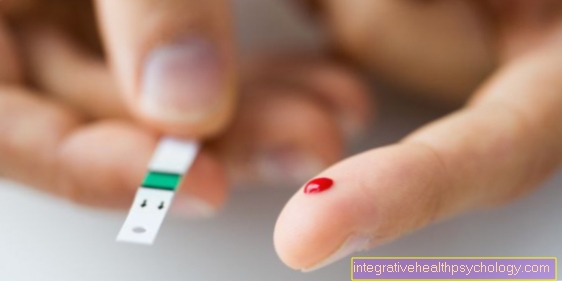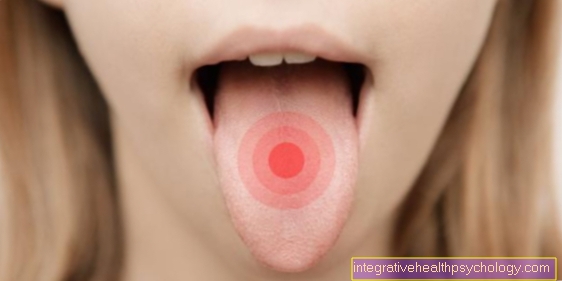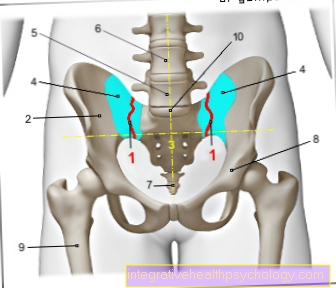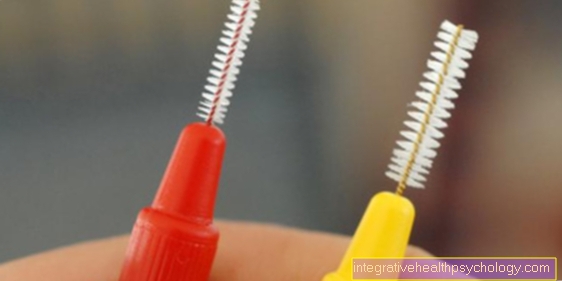Floxal eye ointment
introduction
The Floxal eye ointment is an antibiotic drug used to fight inflammation and infections of the eye. The ointment contains the active ingredient ofloxacin. Like all antibiotics, it can only be used against diseases caused by bacteria.
Floxal eye ointment is used against infections of the anterior segment of the eye, especially the cornea (Cornea) and conjunctiva (Conjunctiva), used. In addition, inflammation of the eye appendages such as e.g. the sebum glands of the eye (Meibom-Glands) to treat.

Indication of Floxal eye ointment
Floxal eye ointment is used when the eye is infected with bacteria against which this drug is effective. First of all, it should be clarified that the inflammation of the eye is caused by bacteria, and not e.g. caused by viruses. This can be done based on symptoms or an eye swab.
A typical symptom of a bacterial eye infection is the secretion of yellowish pus. In addition, itching, redness, swelling and pain of the eye can occur. Poor vision or a clouding of the field of vision is also possible.
The bacteria that often cause eye infections are staphylococci (especially Staphylococcus aureus) and chlamydia (Chlamydia trichomatis). Both pathogens are usually sensitive to the substance in Floxal eye ointment (Ofloxacin). So they can be fought well with this drug.
You can also find out more at:
- Floxal
- Inflammation of the cornea
Floxal for conjunctivitis
With conjunctivitis (Conjuntivitis) the conjunctiva, which shields the eyeball from the outside, is infected with pathogens. As a result, and the counter-reaction of the immune system, the typical symptoms occur: The eye is reddened and itchy, it watery and secretes a watery to purulent secretion. You also get the feeling of having a foreign object in your eye.
Conjuntivitis can be chronic or acute and can have multiple triggers. Viruses are the most common. However, bacteria can also cause this disease, especially in children. If the pathogen is a bacterium against which Floxal eye ointment is effective, this ointment can be used for therapy. However, it is not effective against viruses.
Read on below:
- Eye drops for conjunctivitis
- Treatment of conjunctivitis
Floxal on a stye
The stye (Hordeolum) is inflammation of the lid margin and its glands. A small, encapsulated collection of pus (abscess) often forms. Symptoms are e.g. Pain, swelling, and redness.
In the case of stye, the glands on the inner edge of the lid (maibom glands / sebum glands) or on the outer edge (minor glands / sweat glands, Zeiss glands / sebum glands) can be affected. In no case should the hordeoulum itself be expressed. The disease is mostly caused by bacteria, against which Floxal eye ointment works well. This is especially true for the staphylococci (e.g.. Staphylococcus aureus).
Learn more at:
- How do you treat a stye?
- Eye ointment for a stye
effect
The active ingredient in Floxal eye ointment is called Ofloxacin. It is an antibiotic that prevents bacteria from multiplying.
Ofloxacin intervenes in the reproduction of bacterial DNA (Replication) on. For replication to take place, the DNA must be read and copied by certain enzymes. The DNA is twisted on itself, which is why it must be uncoiled into a straight strand before reading. There are separate enzymes for this task. If an antibiotic works against these enzymes, it is called a gyrase inhibitor. These only attack bacteria and not human cells that lack gyrases.
Ofloxacin is one such gyrase inhibitor. This prevents ofloxacin from uncoiling the bacterial DNA.So it cannot be read and increased. This prevents the bacteria from spreading further. The remaining bacteria are fought by the immune system and the inflammation heals.
side effect
When using Floxal eye ointment, eye reactions such as redness, burning sensation and slight pain may occur. Increased tears, blurred vision or a feeling of foreign bodies can also occur. In addition, dry eyes sometimes occur. However, these symptoms usually go away on their own after a short time.
These symptoms can worsen under UV exposure and lead to photophobia. When using Floxal eye ointment, direct sunlight should therefore be avoided on the eye.
It can also cause an allergic reaction. This is particularly noticeable as swelling of the eye, the surrounding tissue or even the entire face.
In very rare cases (less than 1: 10,000) an allergic reaction of the whole body occurs (systemic allergic reaction). This can e.g. through skin symptoms such as redness and itching, difficulty breathing, diarrhea, abdominal pain or vomiting. A drop in blood pressure also suggests a systemic allergic reaction. If such a reaction is suspected, a doctor should be consulted immediately.
Rarely (1-10,000) there are deposits on the cornea, so-called Vortex Keratopathies. These usually heal without any consequences after the end of therapy with Floxal eye ointment.
You might also be interested in this topic: Side effects of antibiotics
interaction
The active ingredient in Floxal eye ointment, ofloxacin, can interact with various drugs. However, this is only the case if the active substance is absorbed into the whole body (systemically), e.g. as a tablet. As an eye ointment, ofloxacin only works on a limited area (locally). Interactions are not observed with this form of application.
When should Floxal eye ointment not be used?
There is a contraindication (contraindication) for Floxal eye ointment if an allergic reaction has already occurred while using this drug. Otherwise there are no further strict contraindications.
Pregnant and breastfeeding women should also not use Floxal eye ointment. There are insufficient studies on compatibility for mother and child.
dosage
Floxal eye ointment is sold in packs, each containing 3 grams of the active ingredient ofloxacin. To effectively combat bacterial infections in the eye, an approx. 1 cm long strip of ointment should be applied to the affected eye three times a day.
Despite this recommendation, the exact dosage should be clarified with the prescribing doctor. Further information can also be found in the package insert.
How many times a day?
Floxal eye ointment is usually used three times a day. The exact number can vary slightly depending on the type of bacteria (e.g. chlamydia or staphylococci) to be treated. The frequency of use should therefore be clarified with the attending physician. Further information is available from the pharmacy or on the package insert.
Duration of application
The duration of use can vary depending on the severity of the infection and the pathogen. It should therefore be discussed with the attending physician. Independent withdrawal of antibiotics is not recommended, even if the symptoms improve. Otherwise there is a risk that surviving bacteria will develop resistance.
The length of treatment is not specified, but there is a maximum limit: Floxal eye ointment should not be used for more than 14 days.
Right order
For the correct application of Floxal eye ointment, the hands should first of all be as free of germs as possible. It is therefore advisable to wash them thoroughly. It is often easier to apply in front of a mirror.
The lower part of the eye is pulled down slightly with the finger. This releases the conjunctival sac into which the ointment is placed. Start in the corner of your eye on the inside of your nose and pull a strip of the ointment outwards. The eyelashes or the eye itself should not come into contact with the tube of ointment, otherwise there is a risk that pathogens will settle there.
Then the eyes are closed and any ointment that has escaped can be removed with a cloth. It is normal to see blurred vision shortly after applying the ointment. If the application does not succeed, another person can be asked to carry it out.
If eye drops are used at the same time, this should be done every 15 minutes. The eye ointment should be used after the eye drops.
When do the symptoms improve?
When exactly an improvement occurs depends on the severity of the infection and the type of pathogen. In most cases, you will see improvement within 1-3 days. However, if it takes a little longer, it does not mean that the drug is not working. An improvement can also occur later.
Floxal eye ointment can be used for up to fourteen days. If the symptoms do not improve, the attending physician should be informed.
Is the Floxal eye ointment available without a prescription?
Floxal eye ointment is a prescription drug. The active substance Ofloxacin is an antibiotic, these are not sold without a prescription.
Antibiotics can have a variety of side effects or interactions, especially if used incorrectly. Therefore, before using an antibiotic such as Floxal eye ointment, a doctor should be consulted who will prescribe the drug and explain its correct use.
Further information: Eye drops and eye ointments
durability
Floxal eye ointment is stable for 3 years if unopened. After the ointment tube has been opened for the first time, the medication can be used for another six weeks.
price
The price of Floxal eye ointment depends on the type of insurance and any additional payment exemption. Statutory insurance companies contribute five euros to Floxal eye ointment. Privately insured people pay around 15-20 euros. Those exempt from co-payments receive the drug at no cost of their own.
Alternatives
If there is an infection of the eye that requires medication, there are some alternatives to Floxal eye ointment. On the one hand, the active ingredient of this ointment, ofloxcain, is also available in the form of drops.
There are also other active ingredients that can be used to combat bacterial infections of the eye. The antibiotics gentamicin and chloramphenicol e.g. work well against staphylococci. Tetracycline and erythromycin are particularly effective against chlamydia.
also read:
- Eye drops containing antibiotics
- Floxal eye drops
Can be used during pregnancy and breastfeeding?
Use during pregnancy and breastfeeding should be clarified with the attending physician.
Floxal eye ointment mainly works locally, i.e. limited to the eye. However, an effect that affects the whole body (systemically) cannot be unequivocally ruled out. So far there is no evidence of a teratogenic effect. Nevertheless, the data situation is not sufficient here to completely rule this out. Therefore the use should be avoided if possible or discussed with the attending physician.
Also read our topics:
- Medication during pregnancy
- Antibiotics in Pregnancy
Use in children
Floxal eye ointment acts mainly on the eyes (local), but an effect that affects the whole body (systemic) cannot be excluded.
The active ingredient of the ointment, ofloxcain, can damage the cartilage. Children and infants are particularly susceptible to this, as they are still growing. Therefore, Floxal eye ointment should not be used in children and infants.
You might also be interested in: Treat conjunctivitis in children
Recommendations from the editorial team
- Floxal
- Conjunctivitis
- Stye
- Eye drops containing antibiotics
- Eye drops and eye ointments
Exclusion of liability / disclaimer
We would like to point out that medication must never be discontinued, applied or changed independently without consulting your doctor.
Please note that we cannot claim that our texts are complete or correct. The information may be out of date due to current developments.





























